If you go camping often enough, you are bound to experience at least a few rainy days. So long as you are prepared, rain shouldn’t ruin your trip. However, setting up camp in the rain, especially pitching a tent in the rain, can be annoying. Do it incorrectly and the entire inside of your tent can end up drenched.
There are a few methods for setting up your tent in the rain so the inside doesn’t get wet. Here they are.
1. Minimize Wetness
With most double wall tents, you need to set up the inner mesh tent first and then the rain fly. This creates a huge problem because the inner tent lies flat, collecting rain water. You can do some things to minimize the wetness though.
Pack Tent Parts Separately
Instead of rolling all parts of the tent together in the stuff sack, keep the poles, inner tent, and fly separate. This way you can get out the poles first (while keeping the other items covered or somewhere dry) and set them up. If the poles are rolled up inside the tent, you’d have to unroll it to get the poles and expose the tent to water.
Make Sure Fly Is Rolled with the Exterior Outwards
It’s okay if the exterior of the tent fly gets wet, but you obviously don’t want the underneath side to get wet – all that wetness will drip onto the inner tent. Make it a habit to always roll the fly so the exterior is outwards. Then it won’t matter if you set the fly in the rain while pitching the other parts.
Shake Off the Inner Tent before Putting the Fly On
On good tents, even the inner mesh tent is somewhat water-resistant: rain will bead up on the mesh. If you throw the fly on top of this though, the pressure will cause the rain droplets to soak into the mesh. You can remove a lot of those rain droplets simply by giving the inner tent a little shake before throwing on the fly.
Keep Tent Doors Zipped
Make it a habit to to always close doors (and any windows or vents) on the tent when you pack it up. Then they will be closed when you go to pitch the tent. This is important for pitching in the rain because you don’t want water entering through open doors.
Bring a Rain Towel
Have an extra microfiber towel for wiping down the inside of your tent. Unless it was an insane downpour (or it took you forever to pitch), this should be enough to dry your tent before bringing in gear.
Practice
The faster your set up your tent, the less wet it will get. The key here is to practice so you can set up your tent in a matter of minutes. Spend some time practicing how to pitch the tent in your yard or living room. The last thing you want is to embarrassingly struggle to get your tent pitched while also having to deal with mud, puddles, and cold.
Important: Even if you know how to set up your tent, you should still test it – and all other gear — before going camping. Otherwise you might arrive at camp only to realize you are missing a stake, a pole cracked, or some other issue.
2. Choose a Single Wall Tent
Single wall tents have just one waterproof layer. So long as you make sure the door and vents are closed before pitching, you should be able to pitch without any rain getting inside.
However, I personally don’t like most single wall tents. They tend to have issues with condensation so, even if you manage to get the tent up in the rain without getting everything drenched, it will still get wet inside later from condensation.
There are some better, newer-generation single-wall tents though which have improved ventilation so condensation isn’t as much of an issue. Also read: How to prevent tent condensation
3. Wait for the Weather to Get Better
Summertime showers tend to be really intense but don’t last very long. If this is the case, then just wait to pitch the tent. Have fun sitting around in your rain gear or doing other camp tasks until the rain clears.
Tip: If you are car camping and the rain starts just as you arrive to camp, park your car over the spot where you want to pitch your tent. When the rain stops, move your car. Voila! You’ll have a dry, mud-free spot to pitch on.
4. Use a Tarp Rain Shelter
Tie some rope between two trees to make a ridgeline. Then drape a tarp over it and tie out the corners. Suddenly, you’ve got a rain-free area which can be used for cooking, hanging out, shade, or for pitching your tent without getting it wet in the rain.
See this post for ways to set up a tarp shelter. You’ll also need to know these tarp knots.
Some people like to bring multiple tarps so they have one for over their tent and others for around camp.
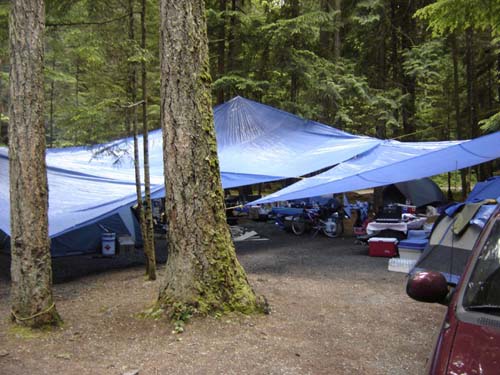
So many tarps!
*Tarps with grommet holes are a LOT easier to set up. You can also get tarps which are specially shaped to make good rain shelters. A basic tarp (like this one) only costs about $15-$20. There are also plenty of other cool tarps available at REI.
5. Use the Fly First Method
The “fly first” method means you first pitch the tent fly and then set up the inner tent, thus allowing the inner tent to stay dry. A lot of ultralight backpacking tents or “fast pitch” tents have this option but you’ll need to buy their ground sheet (which will have grommets specifically placed for that tent’s poles).
Here’s how to pitch fly-first:
- Connect all the poles
- Lay down the ground sheet
- Set up the poles in the ground sheet
- Quickly throw the fly over the poles (you don’t want the ground sheet getting drenched)
- Crawl under the poles with the inner tent
- Clip the inner tent to the poles
- Stake down the tent and any guylines and finish securing the fly in place
Tip: If it’s windy, add some stakes about halfway through. Otherwise your tent fly might blow down the campsite!
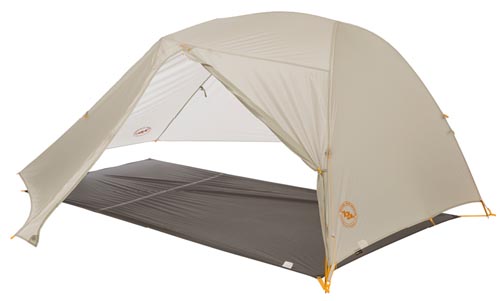
The Big Agnes Tiger Wall tent with the “fly first” pitch method. You then crawl inside and set up the inner tent.
The fly-first method works really well for keeping the inner tent dry while pitching in the rain. However, for it to work you’ve got to crouch and crawl underneath the fly while attaching the inner tent in place. I personally don’t mind this, but I’m really petite and nimble. A taller or larger person might find it annoying.
Some popular tents with the fly-first option include:
- Big Agnes Tiger Wall UL (REI)
- REI Dome Tents with footprints (REI)
- MSR Hubba Hubba tent (REI, Amazon)
- Big Agnes Big House 4 & 6 Person Tents (Amazon, REI)
6. Choose a Tent with Exterior Poles (Exostructure Poles)
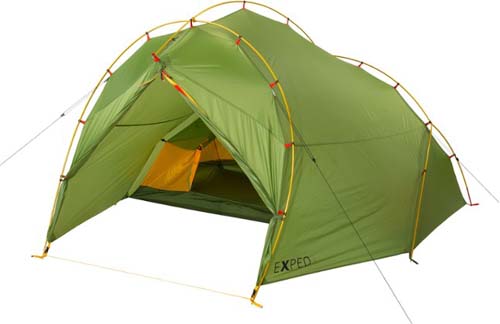
If you know you will be camping in rainy weather frequently, you might want to get a tent which has exterior poles. There aren’t many of these tents available but they usually boast some cool features like:
- Better suited for handling high winds
- Can leave the inner tent attached to the fly for faster setup/takedown
- Fly can be setup on its own without the inner tent
- Completely freestanding
- Very strong construction
Most of external pole tents are quite pricy (at least $400) but are really made for camping in bad weather. It might be worth upgrading to one of these tents if you hate pitching your tent in the rain.
7. Wear Rain Gear
Regardless of which method you use to pitch your tent in the rain, you will still be standing in the rain. Your clothes, hair, and shoes will get drenched (and maybe muddy too), and you’ll just bring all that wetness into the tent when you enter.
Hopefully you already know that you should bring a rain jacket on every camping trip. But rain pants are also really useful. If you are car camping and it’s likely to be muddy, some rubber wellington boots are also nice to have. Leave all wet thing in your tent’s vestibule before entering and your tent interior should stay nice and dry.
Check out:
Important:
When pitching a tent in the rain, it’s really important that you choose the right site. The site can end up flooded or even get washed away. Dead tree limbs – aka widowmaker trees — can also fall onto your tent and kill you! Make sure you stay safe and comfortable. Read: What to Do When It Rains While Camping and Camping during a Thunderstorm.
Resources:
https://outdoors.stackexchange.com/questions/6084/pitching-a-tent-in-the-rain
https://www.reddit.com/r/bicycletouring/comments/65ltzz/tents_with_a_rainfly_that_can_be_attached_while/dgbscox/
https://www.whiteblaze.net/forum/showthread.php/127080-Pitching-Fly-first-BA-tents
Image credits:
“Rainy Campsite” (CC BY-SA 2.0) by Martin Cathrae
“DSC02157” (CC BY 2.0) by Jug Jones


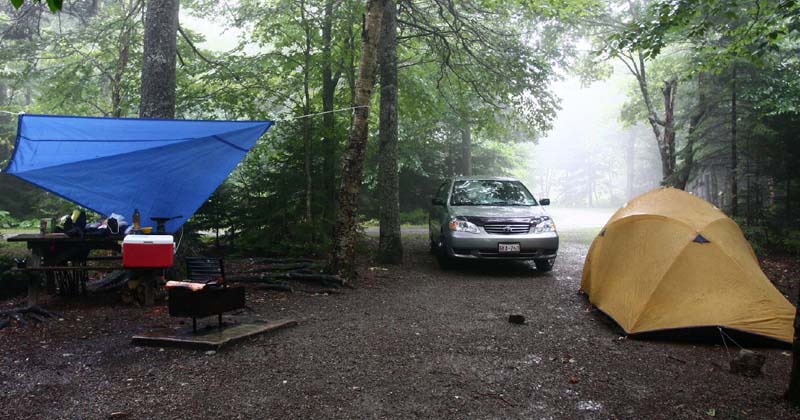
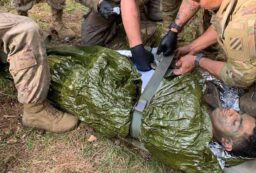
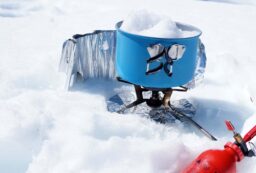








Post your comments